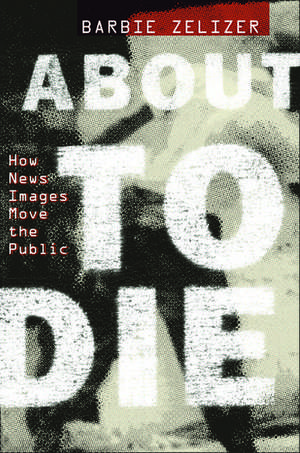About to Die: How News Images Move the Public
Autor Barbie Zelizeren Limba Engleză Hardback – 13 ian 2011
Preț: 690.19 lei
Preț vechi: 975.23 lei
-29% Nou
Puncte Express: 1035
Preț estimativ în valută:
132.07€ • 141.23$ • 110.12£
132.07€ • 141.23$ • 110.12£
Carte tipărită la comandă
Livrare economică 07-14 aprilie
Preluare comenzi: 021 569.72.76
Specificații
ISBN-13: 9780199752133
ISBN-10: 0199752133
Pagini: 432
Ilustrații: 50 black and white illustrations
Dimensiuni: 236 x 163 x 33 mm
Greutate: 0.75 kg
Editura: Oxford University Press
Colecția OUP USA
Locul publicării:New York, United States
ISBN-10: 0199752133
Pagini: 432
Ilustrații: 50 black and white illustrations
Dimensiuni: 236 x 163 x 33 mm
Greutate: 0.75 kg
Editura: Oxford University Press
Colecția OUP USA
Locul publicării:New York, United States
Recenzii
Zelizer bolsters her arguments with extensive primary research, including readers' reactions from letters to the editor and blog postings regarding daring and shocking images. Her seventy-nine pages of notes are a treasure trove to readers and researchers because they are so detailed and thorough.
Why are some deaths fit spectacles for the camera and others off-limits? What philosophical and social purposes do news images serve? Barbie Zelizer answers such questions in this ambitious new book, a stunning examination of a little-explored aspect of modern journalism.
In Barbie Zelizer's most powerful, profound, and disturbing work, she shows that news photos do not document reality but are suspended precariously between the 'as is' and the 'as if,' touching feelings, touching off imaginations. With an astonishing cascade of evidence about iconic news images and the stories behind them, Zelizer offers little comfort, no certainty, but much illumination.
About to Die is an audacious and often chilling examination of how visual media handle the moment of death, from engravings of the Great Chicago Fire of 1871 to the Pacific tsunami of 2004. With an obvious and admitted debt to the academy's favorite photography buff Susan Sontag, Zelizer treats these images as both rare and powerful.
An enlightening new book.
Why are some deaths fit spectacles for the camera and others off-limits? What philosophical and social purposes do news images serve? Barbie Zelizer answers such questions in this ambitious new book, a stunning examination of a little-explored aspect of modern journalism.
In Barbie Zelizer's most powerful, profound, and disturbing work, she shows that news photos do not document reality but are suspended precariously between the 'as is' and the 'as if,' touching feelings, touching off imaginations. With an astonishing cascade of evidence about iconic news images and the stories behind them, Zelizer offers little comfort, no certainty, but much illumination.
About to Die is an audacious and often chilling examination of how visual media handle the moment of death, from engravings of the Great Chicago Fire of 1871 to the Pacific tsunami of 2004. With an obvious and admitted debt to the academy's favorite photography buff Susan Sontag, Zelizer treats these images as both rare and powerful.
An enlightening new book.
Notă biografică
Zelizer is Raymond Williams Chair of Communication and the Director of the Scholars Program in Culture and Communication at the Annenberg School for Communication at the University of Pennsylvania. She is the editor of several collections and the author of Remembering to Forget: Holocaust Memory through the Camera's Eye and Covering the Body: The Kennedy Assassination, the Media, and the Shaping of Collective Memory.
